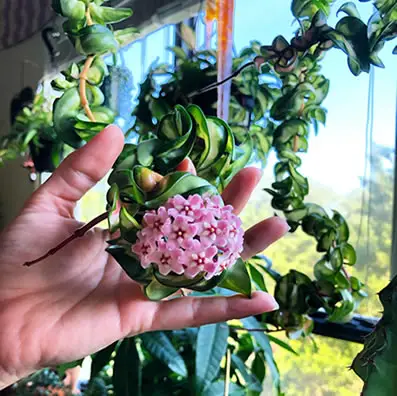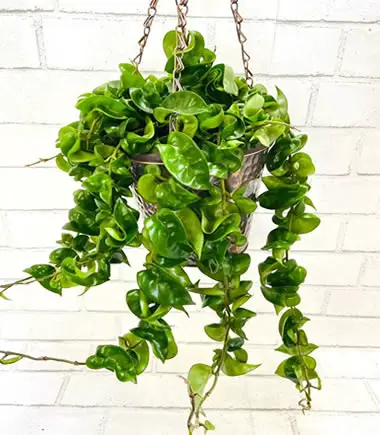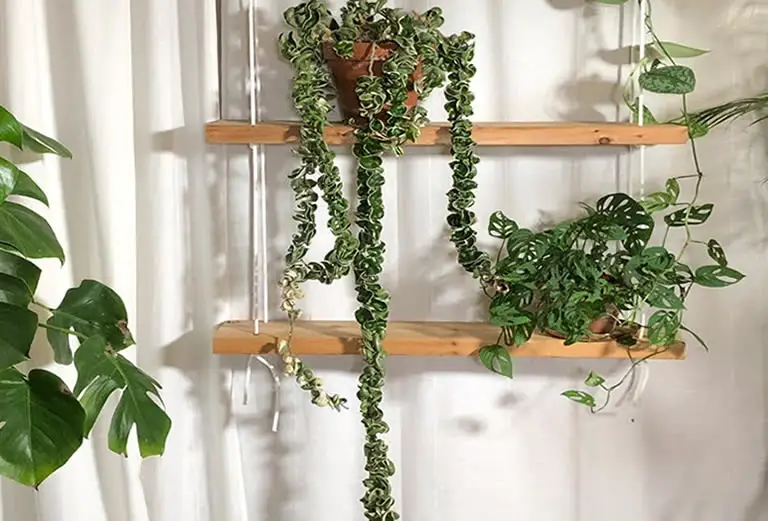The hindu rope plant is a truly unique and beautiful houseplant that is grown across the US. However there is a lot of confusion about what exactly a hindu rope plant is and how to care for it. In this article I will clear up all confusion about this plant and give you detailed, but easy to apply, care instructions for this distinctive flowering hanging houseplant.
Table of Contents
- A brief overview of the hindu rope plant – Hoya carnosa compacta
- The hindu rope plant is not a true succulent
- The 7 Hindu Rope Plant Care Essentials
- The best soil for a hindu rope plant isn’t a succulent soil!
- The best pot & pot size for a hindu rope plant may actually be a basket
- The best fertilizer for a hindu rope plant should be low strength
- Hindu rope plant light requirements must be observed
- The ideal temperature range for growing a hindu rope plant
- A Hindu rope plant requires higher than normal humidity levels
- How to water a hindu rope plant the right way
- A Quick Note About Caring For A Hindu Rope Plant Outdoors
A brief overview of the hindu rope plant – Hoya carnosa compacta
Before I delve into the finer details of caring for this truly unique plant I want to give you a quick overview of the plant. So first off, what exactly is a hindu rope plant?
The hindu rope plant is a perennial semi-succulent and member of the Hoya family.
Its botanical name is Hoya carnosa compacta but it is also known as the curly wax plant and the Hoya rope plant. It is a semi-rare hanging vine that resembles a rope and is native to India, Australia and other parts of Eastern Asia. It is grown in the US mostly as a houseplant.
The hindu rope plant produces pink blooms in spring and summer.
In its natural state, and native habitat, the Hindu rope plant is epiphytic meaning it relies on other plants in order to grow – the hindu rope plant will attach itself to another plant, such as a tree, for support.

This means the hindu rope plant has evolved to have a root system that requires good airflow as in its native habitat the roots are more exposed than those of soil-based plants. It therefore requires a very specific kind of soil when grown as a houseplant or outdoor hanging plant.
Additionally, the fact that it grows on large plants, such as trees, means the hindu rope plant has evolved to grow in areas that do not have direct exposure to the strong direct sunlight of the tropics.
Being a tropical plant means that it also has some specific temperature and humidity needs which I will cover in the appropriate sections below.
Sharing similarities, in both appearance and qualities, to many succulents it seems common sense to assume that the hindu rope is a succulent, but is it?
The hindu rope plant is not a true succulent
There is much confusion about the hindu rope plant. Many gardeners and indoor houseplant cultivators state that this plant is a succulent but is that true?
The hindu rope plant is considered to be a semi-succulent. Although it has succulent leaves, it has different care requirements to the average succulent. It is not truly a succulent in the strictest sense.
As you will see as you read through this article, the hindu rope plant has some succulent qualities that means the plant does require a succulent type approach to its care. At the same time though, it also has non-succulent qualities which means it has some care requirements that are unlike those of a succulent.
Because the Hoya carnosa compacta has a mix of succulent and non-succulent traits, this often causes confusion with plant growers leading them to give the plant improper care, especially if they incorrectly assume it is a succulent.
However, if you follow the simple advice I outline below you will find your hindu rope plant flourishing and producing spectacular blooms in late spring or early summer. Note though, that it takes several years for a Hindu rope plant to mature enough to produce flowers.
The 7 Hindu Rope Plant Care Essentials
Below are the 7 essentials you must get right if you want to grow a healthy, vibrant hindu rope plant the blooms every year.

Although this Hoya is an easy-care plant if you get any of the simple 7 essentials wrong you run the risk of having a sickly hindu rope plant or even of losing your plant.
Below is a quick guide for hindu rope plant care that you can come back to and review multiple times if you need to.
I do advise you to read the entire article though at least once so you understand the small details of the care requirements of this plant.
The 7 basic hindu rope plant care requirements
Soil: Contrary to popular belief succulent soil is not suitable for hindu rope plant. You need a well-draining soil that also promotes good airflow. Soil with a 1 to 1 ratio of compost to perlite is ideal.
Pot: Hindu rope plant is best suited to a small hanging basket. If you intend to place it on a shelf or similar then a terracotta pot is better for the reasons outlined below.
Fertilizer: Like succulents, hindu rope plant requires less nutrients and minerals per feeding than the average houseplant. If using regular fertilizer make it up to half strength or use a succulent feed like the one outlined below. Unlike succulents though you should feed your Hoya carnosa compacta every 2 months during growing season.
Light requirements: Ensure your Hoya gets at least 4 – 6 hours of good indirect light per day. Avoid placing the plant in the path of direct sunlight.
Temperature requirements: The hindu rope plant requires temperatures in the range of 65°F – 80°F. The average American home has a temperature of about 70°F and so is suitable for growing this Hoya.
Humidity needs: The hindu rope plant requires much higher humidity levels than those found in the average home. The plant needs 40% – 60% humidity. You can use a number of methods to ensure your hindu rope houseplant experiences high humidity without it affecting the rest of your home.
Watering requirements: The hindu rope plant requires much less watering than most other houseplants. Water it only when the top layer of soil dries out – usually about every 2 – 3 weeks.
The best soil for a hindu rope plant isn’t a succulent soil!
Although the leaves on a hindu rope are indeed succulent in nature this unique plant will not fair well in regular succulent soil. Store-bought succulent soil will be comprised of one-third compost, one-third perlite, vermiculite or similar and one-third sand. However, sand is too dense for a hindu rope plant as the sand will compact in the soil mix and make it difficult for air to penetrate the soil thus cutting off much needed airflow to the roots.
Hindu rope plant has evolved to require good airflow to the root system as it naturally grows on other plants, such as trees, where the roots are much more exposed than those of ground-based plants. So this is why it is essential you use soil that promotes good airflow.
So what kind of soil should you use for hindu rope plant?
The kind of soil used for hindu rope plant should be well draining but also light enough to allow for good airflow. It is best to mix your own soil by using standard potting mix with perlite or oak bark at a rate of 1:1.
Remember most succulent soils will not be suitable due to the sand content of the mix. So, although they are fast draining soils, which is essential for a hindu rope plant, they restrict airflow to the roots, which is bad for a hindu rope plant.
Regular potting mix on its own is much too rich and will retain too much moisture for a hindu rope plant, so it is often better to produce your own soil mix.
To prepare your own soil mix, simply mix 1 part potting mix to 1 part perlite and you will have a perfect soil for your plant. Although perlite is very easy to source – see here – you can substitute it with vermiculite or wood bark if you have some at hand.
The best pot & pot size for a hindu rope plant may actually be a basket
As hindu rope plant is a vine that has foliage which drops downwards away from the plant, rather than growing upwards, it is excellent for hanging baskets.
I find that smaller hanging baskets work really well with hindu rope plants as this semi-succulent is a slow grower and prefers to be rootbound.
Even when using a reasonably small basket you will not have to repot the plant until it becomes extremely rootbound in its container, which will take years.
If you intend to place the hindu rope plant on a shelf or similar location where the foliage will hang down, consider using a terracotta pot.
As I have mentioned many times across this website, terracotta is excellent for increasing localized humidity levels directly around the plant eliminating the hassle of regular misting or the expense of a humidifier (more on humidity later).
The best fertilizer for a hindu rope plant should be low strength
The hindu rope plant is similar to succulents in the fact that it requires much less fertilizer than most other houseplants.
If you are using a regular houseplant feed then you must dilute it to half strength for this curly wax plant, just as you would with succulents.
Alternatively you can use a good quality liquid succulent feed and use it exactly as described in the instructions on the bottle.

However, unlike succulents you will want to fertilize your hindu rope more often than you fertilize your succulents.
During growing season be sure to fertilize your curly wax plant once every 2 months to encourage blooming. This little trick will help your Hoya carnosa compacta to produce vibrant and colorful blooms as well as giving the leaves that lush glossy wax-like look that the plant is famous for.
Hindu rope plant light requirements must be observed
Although the hindu rope plant can survive and grow in low light conditions if you want to get the most from your plant it is best to provide it with strong indirect light.
This plant requires at least 4 – 6 hours of good indirect light per day though more than that is perfectly fine. Any less than this will slow the growth of this Hoya however and lead to weaker foliage color and a lack of blooms.
Never allow a hindu rope plant to sit for long periods in direct sunlight. To be on the safe side just avoid placing the plant anywhere that gets direct sunlight.
The ideal temperature range for growing a hindu rope plant
Hoya plants will grow best in temperatures ranging from 65°F – 80°F. As the average US household has a regular temperature of about 70°F in both winter and summer, thanks to climate control systems, hindu rope plant will grow well in the typical American home.
Avoid placing the Hoya rope plant anywhere that experiences temperatures below 50°F as this plant is not cold-hardy.
A Hindu rope plant requires higher than normal humidity levels
The hindu rope plant, although a great houseplant, does require higher humidity levels than the normal home experiences.
While homes usually have humidity levels of 30% and below, the hindu rope plant requires humidity levels of 40% – 60%.
Anyone who has been to New York in September, or Ireland in November, will already know that high humidity levels are extremely uncomfortable for human beings. So how do you increase humidity levels around your plant without having to increase humidity levels throughout your home?
The most popular method of increasing humidity levels directly around a plant is through misting.
By misting around the Hoya you increase the moisture levels in the air thus increasing humidity. This does work to some extent though it is the least effective method for increasing humidity as it only increases the humidity levels while the water remains in the air, as it falls to the ground the surrounding air loses its humidity.
A better way of increasing localized humidity around a plant is to place a tray filled with pebbles and a little water directly underneath your plant. This way the water is constantly evaporating into the air around the plant. be careful to only add a little water and top it up as it evaporates – Hoya carnosa compacta hate to sit in water and if you put too much water in the tray the plant will likely develop root rot.
Another great way for increasing humidity is to use a small terracotta pot. Terracotta pots naturally wick away moisture from the soil to the outside of the pot where it is evaporated into the air. This not only helps to increase localized humidity levels around your plant but it also regulates the moisture levels in the soil.
Obviously the last two methods for increasing humidity are useless if you have a Hoya carnosa compacta curly wax plant that is growing in a hanging basket. Although you can use misting to help increase humidity levels I would advise you instead to use a small plant humidifier. You can get a really good one, like this, for less than 20 bucks and they work great with Hoya plants.
How to water a hindu rope plant the right way
When it comes to your watering routine you should treat a hindu rope plant like a succulent.
Succulents require much less watering than most other houseplants and a mistake many houseplant owners make is to water their succulents at the same time and in the same regularity and quantity as their other plants.

The hindu rope plant should only be watered when the top 1½ to 2 inches of soil has dried out – or about half way down the pot.
Use the finger test that I have outlined many times on this website or simply buy a cheap moisture meter. If using a moisture meter only water your hindu rope plant when the meter reads “dry”.
For more on the proper hydration of Hoya plants read our article how often should you water a Hoya.
A Quick Note About Caring For A Hindu Rope Plant Outdoors
Can you grow a hindu rope plant outdoors?
You should only grow hindu rope plant outdoors in USDA hardiness zones 10 – 12. However, in most US states you can bring your Hoya carnosa compacta houseplant outside in the warmer summer months as long as you protect it from heavy rain and direct sunlight.
Hang the plant is a shaded area that gets good indirect light and then water and fertilize it as normal.
Be sure to bring your Hoya rope plant back indoors when temperatures start to cool with the changing seasons. Read our guide to protecting plants against frost for cool ways to protect yard plants.
If you fail to protect the plant from cold temperatures your hindu rope plant will develop problems that you may be unable to fix.

